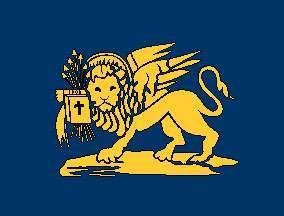Ionian Flag - 1800-1807
The study of flags is called vexillology - from the Latin - "vexillum" - which was the metal standard - (often, the eagle) - that Roman armies carried as they advanced into battle.
The word may not be in some of your dictionaries - as it was only introduced into the English language in 1956 - in an article by Witney Smith in the Flag Bulletin. (USA).
Vexillography is the art of designing flags.

Image by Antonio Martins.
From:
http://www.nationalflaggen.de/flags-of-the-world/flags/gr-ion.html#bri
"The State of the Ionian Islands (1800)- of which Kythera was a part - introduced a blue flag with the winged lion of Saint Marcus holding the Gospel, from which sprung seven lances symbolising the seven Ionian Islands. In the years of the Venetian occupation the flag was white bearing the winged lion, while on the canton (the uppermost left hand corner from the viewer's perspective - the honour point of the flag) - there was a depiction of each island's patron saint, with a cross."
"The first official flag for an independent Greek state after the fall of Constantinople was the flag of the independent Ionian Republic. It was introduced in 1800 after a treaty which proclaimed the Ionian Islands a free and independent state. This flag remained in use until 1807, when the Ionian Islands were returned to France."
The Venetian winged lion, can be seen on the stonework to the Entrance at Milopotamos. (See Harry Feros's photograph, in the Architecture section.)
George C Poulos
Executive Director, Australian Iconography Foundation
Senior Member, Flag Society of Australia
Member, Heraldry Australia Inc.
Vexillographer, Official Bondi Beach Flag.
Vexillographer, Hawkesbury Waratah Festival Flag.
Vexillographer, Karavitiko Symposium Flag.
Vexillographer, Australian Total Reconciliation Flag.